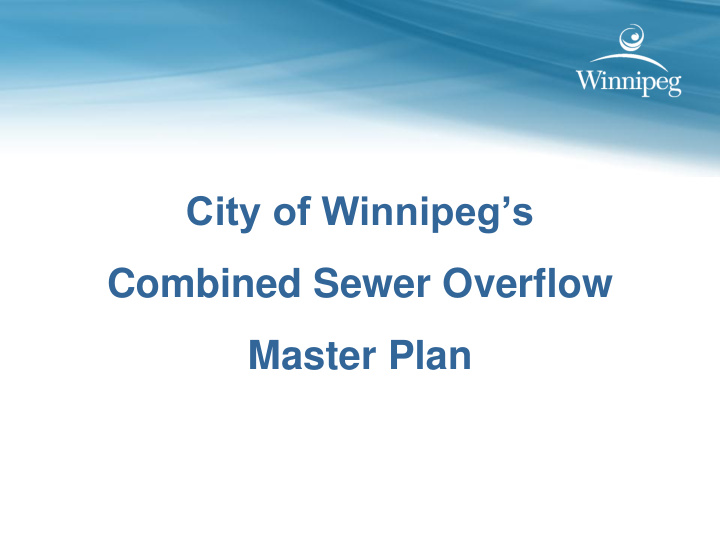



City of Winnipeg’s Combined Sewer Overflow Master Plan
Outline Winnipeg’s Sewer History All about Combined Sewers Progress on Addressing Combined Sewer Overflows Combined Sewer Overflow Licensing The Combined Sewer Overflow Master Plan Next Steps 2
Winnipeg’s Sewer History 1880’s - 1930’s sewers were constructed and flowed to the rivers 1930’s - 1960’s construction of sewage treatment plants construction of interceptor sewers (divert dry weather flows to treatment plants) most new sewers were combined sewers 1960’s - today installing separate sewers only 3
What are combined sewers? A single pipe system, built between 1880’s and 1960’s, that collects both: wastewater from homes and businesses, and rainfall runoff and snow melt 4
5
Combined Sewer System area 43 combined sewer districts 79 combined sewer outfalls 1037 km of pipe Sewage Treatment Plant Combined Sewer Area North End Collection Area South End Collection Area 6 West End Collection Area
What is a combined sewer overflow? During dry weather, all flow in the combined sewers is carried to the sewage treatment plants During heavy rainfall or snowmelt, designed to overflow when the additional volume exceeds the capacity of the combined sewer system the excess drains directly to the river without reaching the sewage treatment plant called combined sewer overflows (CSOs) On average, occur about 22 times/year Typically 1% of the total annual sewage collected is lost through CSOs 7
8
9
Why do combined sewer overflows occur? Help protect against basement flooding Help protect sewage treatment plant and collection system
Are CSOs unique to Winnipeg? Many older cities had combined sewer systems Most still have CSOs when it rains Most are working to reduce CSO impacts 11
Why should we reduce CSOs? Every time there is an overflow, there is a temporary discharge to the river of: bacteria floating debris organic material common urban pollutants from land drainage (e.g., oils, lawn/garden fertilizers) 12
Have we investigated CSOs? 2002 was the first major * Winnipeg CSO study started in 1993 multi-year planning study of CSO impacts submitted during Clean Environment Commission public hearings in 2003 *From 2002 Report Cost implications: costs rise exponentially to reduce the number of CSOs 13
What have we accomplished to date? Identified and reduced dry weather overflows through system upgrades upgrading pumps, raising weirs, replacing pipes Identified and removed large inflows into the sewer system (e.g., ditches connecting to the sewer system) Developed and installed a computer monitoring system to provide early detection of high sewer levels and allow crews to respond and mitigate
What CSO projects are complete? Invested over $75 million on investigating and reducing CSOs: CSO outfall monitoring program pilot stormwater retention tank revised low-impact development standards to limit runoff interceptor and collection system sewer flow monitoring sewage pumping station improvements and capacity upgrades
What CSO projects are complete? (cont’d) Combined sewer renewals and replacements Combined sewer and basement flood relief studies Combined sewer separation projects 1389 hectares separated out of 9705 hectares of combined sewer district
CSO Master Plan Timeline 17
CSO Master Plan Timeline 18
What are the CSO regulatory requirements? The Province: has regulatory responsibility since enactment of the Environment Act in 1988 Manitoba Conservation and Water Stewardship issued Environment Act Licence No. 3042 (EA No. 3042) Federal Requirements (2012) policy for CSOs requires identification of discharge points and annual reporting of overflows 19
What are we required to do under Environment Act Licence No. 3042? Issued by the Province of Manitoba on September 4, 2013 City will undertake work to: develop a better understanding of CSO impacts and evaluate options develop a long-term implementation program City will report back to the Province with a: Preliminary Proposal by December 31, 2015 Final Master Plan by December 31, 2017 20
What are we required to do under Environment Act Licence No. 3042? (cont’d) Public education plan submitted December 31, 2013 CSO event reporting procedure submitted December 31, 2013 Water quality monitoring plan submitted January 31, 2014 Public notification system of CSO events to be submitted by December 31, 2015 21
What needs to be included in the preliminary proposal? CSO limits to be evaluated: EA No. 3042 requires: maximum of 4 overflows events per year zero combined sewer overflows at least 85% capture and a maximum of 4 overflow events/year explore other relevant control limits 22
What CSO control limits are used elsewhere? Maximum use of existing infrastructure Nine minimum controls (US CSO Policy) Environmental equivalent of separation (Edmonton) No more than 4 to 6 overflows/year (US CSO Policy) Capture and treat 85% of wet weather flows (US CSO Policy) River water quality standards: not established for CSOs impacts 23
How will we evaluate CSO control limits? Criteria to evaluate CSO Control Limits: feedback from the SAC feedback from the public engagement process affordability constructability maintainability environmental stewardship 24
What are CSO control options? Control Option Concerns Sewer separation Disruption, residual untreated stormwater System flow balancing and Modest control improvement, risk of real time controls increased basement flooding Increase wet weather Would threaten existing sewage plant treatment at plants licence compliance Conveyance-storage tunnels Constructability and maintenance Green infrastructure Modest control improvement, drainage retrofit takes decades, 25
What are the next steps? Work on CSO Master Plan is in progress Technical evaluations are underway Additional Stakeholder Advisory Committee meetings Regular liaison meetings with Provincial staff 26
Recommend
More recommend